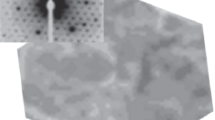Abstract
The crystal structure of molybdenum cementite Mo12Fe22C10 (ξ-phase) has been determined by means of a single crystal x-ray diffraction study of crystal fragments. The lattice parameters were found to be:a=10.865 (3),b=7.767 (2),c=6.559 (2) Å and β=120.13 (2)°, space group C2/m;Z=1. From the analysis ofPatterson maps and differenceFourier analysis the atomic parameters were derived, yielding a residual ofR=0.059. The crystal structure contains octahedral and triangular prismatic groups which accommodate the carbon atoms in their voids, as is usually found in interstitial compounds. The octahedral building group consists of four Mo- and two Fe-atoms, the triangular prism is built up by four Fe-and two Mo-atoms. The mode of filling of the metal polyhedra is discussed.
Zusammenfassung
Die Kristallstruktur von Molybdän-Zementit, “Mo12Fe22C10” (ξ-Phase) wird auf Grund von Einkristall-Beugungsaufnahmen unter Anwendung vonPatterson-and DifferentialFourier-Analysen bestimmt. In der monoklinen Elementarzelle (a=1.870;b=7.67;c=6.563 Å, β=120.1°) Raumgruppe C 2/m befindet sich eine Formeleinheit Mo12Fe22C10 (oderZ=2, Mo6Fe11C5). DerR-Wert von 6% für 1200 Reflexe unterstreicht die Richtigkeit der Struktur, die aus oktaedrischen und trigonal prismatischen Gruppen aufgebaut ist. Die Oktaedergruppe besteht aus 4 Mo- und 2-Fe-Atomen, die trigonal prismatische Gruppe aus 4 Fe- und 2 Mo-Atomen. Die Kohlenstoffatome füllen die Lücken dieser Bauelemente, wie es für typische Einlagerungscarbide (Komplexcarbide) erwartet werden kann.
Similar content being viewed by others
References
Kuo K., J. Iron Steel Inst.173, 363 (1953);184, 258 (1956).
Habraken L., Rev. Met.5, 51 (1954).
Dyson D. J., Andrews K. W., J. Iron Steel Inst.191, 325 (1964).
Craig B. D., Scripta Met.15, 91 (1981).
Wayne S. F., Nowotny H., Rev. Chim. Min.20, 528 (1983).
Busing W. R.,Martin K. O.,Levy H. H., ORNL-TM-305 (1962).
International Table for X-ray Crystallography, Vol. IV, p. 99. Birmingham: Kynoch Press. 1974.
Zachariasen W. H., Acta Crystallogr. Sect.A 23, 558 (1968).
See:Pearson W. B., A Handbook of Lattice Parameters and Structures of Metals and Alloys. Oxford: Pergamon Press. 1967.
Nowotny H., Angew. Chem.84, 973 (1972).
Author information
Authors and Affiliations
Rights and permissions
About this article
Cite this article
Rapposch, M., Kostiner, E., Wayne, S.F. et al. The crystal structure of the molybdenum cementite Mo12Fe22C10 (ξ-phase). Monatsh Chem 116, 1237–1245 (1985). https://doi.org/10.1007/BF00811096
Received:
Accepted:
Issue Date:
DOI: https://doi.org/10.1007/BF00811096



